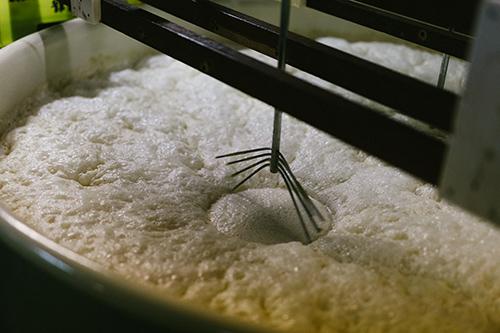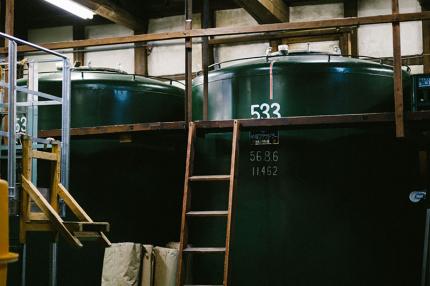YEASTS: SINGULARITY, FRAGRANCES AND MAGIC
We could define the creation of bread, beer, wine and sake as a unique reaction to a magical fungus. Described as a living organism by Louis Pasteur in his 1857 treatise Mémoire sur la fermentation alcoolique, the yeast saccharomyces cerevisiae finds its roots in the Greek (sugar = saccharomyces) and Latin (cerevisiae = beer).
Without this yeast placed in an anaerobic environment (oxygen-free), alcoholic fermentation (transforming sugar into alcohol) would be impossible. The latter will consume the sugar and transform it into alcohol and, at the same time, create CO2. During this process, other reactions take place, including the creation of esters (aromas), various acids and other aromatic compounds that provide the taste and aroma profile.
This development process is controlled by temperature, among other things. Temperature influences yeasts' reaction (for sake, development is essential, around 15 °C – 18 °C). Therefore, it is easy to assume that yeasts are associated with the notion of terroir, i.e. the singularity of the different types of sake. Few kuras are heated or have thermo-regulated tanks, so the climate of the prefecture and the off-season's climatic conditions will directly influence the yeasts chosen. Remember that the Japanese archipelago stretches from the 45th parallel to the 31st parallel, the distance between Lyon and northern Egypt, with temperature differences that can be as much as 10 °C in winter.
Yeasts can be indigenous (naturally present in the air) or selected, as in the winemaking world. With sake, most yeasts are chosen for historical reasons and reflect the philosophy of each kura.
THE SELECTED YEASTS
The National Research Institute of Brewing (NRIB) has enabled the commercialization of selected yeasts, improving the overall aroma quality of the various sake products. The goal of the research center is to harmonize sake quality and avoid possible deviations. Since taxes for sake production represent a significant revenue source for the government, it has made support for this industry a priority.
In 1895, Dr. Kikuji Yabe isolated the first yeasts from a moromi (a fermenting sake batch); later, the NRIB had the idea of asking the country's kuras to send in their yeasts to identify the top performer, clone it and sell it. In 1906, NRIB marketed its first yeast from the Sakura Masume kura in Hyogo and named it simply "Kyokai 1".
Over the years, the NRIB added new yeasts to the "catalogue" and discontinued others. The overall trend since 1906 has been to find more aromatic yeasts that produce less acidity. This evolution of yeast styles reflects consumer tastes (which demand aromatic, less acidic sake) and the development of sake styles (such as the advent of daiginjo in the 1980s). From an aromatic point of view, the new yeasts help create two dominant molecules: ethyl caproate and isoamyl acetate; these offer very fruity aromas of melon, apple, pear and banana.
Yeast Summary Table
| KYOKAI # | YEAR | CITY | KURA | CHARACTERISTICS | UTILIZATION |
| # 1 | 1906 | HYOGO | Sakura Masume .ICHIGO. | Pº Acidity Tº high | x |
| # 2 | 1908 1911 | KYOTO | Gekkeikan | - | x |
| # 3 | 1914 | HIROSHIMA | Suishin | - | x |
| # 4 | 1924 | HIROSHIMA | - | - | x |
| # 5 | 1923 | HISROSHIMA | Kamotsuru | Aromatic High acidity | x |
| # 6 | 1930 | AKITA | Aramasa ROKUGO. | Robust Fermentation at low temp. High acidity | x |
| # 7 | 1946 | NAGANO | Masumi NANAGO | Low temp. Very aromatic Most used for many years | x Yeast of reference |
| # 8 | 1978 | NRIB | NRIB | Mutant # 6 High acidity High fermentation temperature | x |
# 9 Kumamoto Kobo | 1953 | KUMAMOTO | Koro-Kumamoto Center | Complex aromas: melon, apple Widely used | x Ginjo yeast |
# 10 Ogawa kobo | 1952 | IBARAKI | Meiri Shurui | Slow fermentation at low temperature Slightly acidic Sensitive to alcohol | x A Tohoku yeast |
| # 11 | 1975 | Mutant # 7 | - | Alcohol tolerant Low in amino acids Very dry | x |
| # 12 | 1965 | MIYAGI | URAKSUMI | Slow fermentation Not very aromatic | x Yeast Yeasts 7, 9 and 10 have pluMiyagi??? |
| # 13 | 1979 | Crossing of # 9 and # 10 | Aromatic Low acidity Junmai | x | |
# 14 Kanazawa kobo | 1996 | KANAWASA INSTITUTE | Juicy and ripe sake Banana and pear (Isomyl) | x |
THE FORMAT
Often sold as small 10 ml medical ampoules with 20 billion yeasts inside! Each kura uses its own dosage in terms of quantity, depending on the rice polish level and the type of sake to be produced.
TYPES OF COMMERCIALISATION:
- EKIJO KOBO: liquid yeast
- DEIJO KOBO: yeast paste
- KOKEI KOBO: solid yeast (dehydrated Deijo kobo)
- KANSO KOBO: dry yeast (less than 10 % humidity)
HOW TO RECOVER THE YEASTS?
The method is simple: recover the foam produced during fermentation. It contains a huge population of yeasts which are then dried, allowing their storage and transport (this process has been used since the 12th century).
INDIGENOUS YEASTS
In the world of sake, indigenous yeasts are complex. First of all, they can only be used with traditional (yamahai and kimoto) moto (starter tanks). These methods allow the creation of a favourable environment and wait for the spores (yeasts) to settle in it (unlike so-called "modern" methods, such as sokujo, which necessarily involve the addition of yeast). The risks associated with this waiting are numerous:
- non-adapted yeasts;
- low resistance which can cause a halt in fermentation;
- development of undesirable volatile compounds and an increase in the production of acetic acid, which is little appreciated by purists;
- presence of contaminating yeasts (associated with aromatic deviations).
MAJOR DEVELOPMENTS
THE NON-FOAMING YEAST REVOLUTION – AWA-NASHI YEAST
The creation of foam during fermentation is a natural phenomenon. The yeast walls are hydrophobic so that they cling to the gas bubbles (CO2) created during fermentation and thus prevent them from bursting. This excessive foaming causes two significant problems in the sake world:
- its tendency to stick to the walls requires constant cleaning of the fermenting tank to prevent the development of undesirable microorganisms;
- there is a significant loss of space in the fermentation tanks since the foam can take as much space as the must.
- For example, to produce 100 litres of sake, the tank will need to be 200 litres in size, since 100 litres of foam will form.
Awa-1 Protein
In 1963, Professor Akiyama San began investigating the famous Awa-1 protein, responsible for forming this foam. In 1971, the first yeasts lacking the Awa-1 gene (which makes the yeast wall hydrophilic) were born, finally limiting undesirable foam formation. Thanks to this revolution, today's foam creation represents only 20 % to 30 % of the fermentation tank.
Thus, yeasts ending in 01 are often the same as the classic Kyokai, but they limit the foam:
- yeast 6 -> 601;
- yeast 7 -> 701;
- yeast 9 -> 901.
Some purists will tout the virtues of foam creation and its impact on the product. As in all phases of evolution, the detractors are making themselves heard. However, non-foaming yeasts represent no less than 80 % of the yeast market – a real revolution!

THE ARRIVAL OF ULTRA-AROMATIC YEASTS
The "ZENKOKU SHINSU KANPYOKAI" – the national competition of new sake, created in 1910 by the National Research Institute of Brewing (NRIB), is a competition that aims to highlight the skills of the toji. It is an exercise in style where the most important thing is to stand out from the competition. As in an anonymous tasting of 200 wines, the jury often seeks the unique or most expressive sake. This phenomenon of recognition among peers in Japan has led to the creation of ultra-aromatic yeasts: these yeasts push the flavour of ethyl caproate (green apple and melon) to the extreme, to obtain the most aromatic sake possible.
Today, there is even a code that represents the recipe for competition sake: YK35, or daiginjo-type sake, made with yamada nishiki rice, 35 % polished, with kumamoto yeast (#9), etc. To do so, some even decided to crossbreed yeasts to increase their aromatic power. The following are a few examples presented in the table below.
| KYOKAI # | YEAR | CITY | KURA | CHARACTERISTICS | ACTUAL |
| # 1501 | 1996 | AKITA | Low acidity Aromatic | x | |
# 1601 # 86 | Crossbreed # 7 and # 1001
| KYOTO | Gekkeikan | Low acidity Aromatic Large quantity of ethyl caproate | x |
| # 1701 | More acidic than # 1601 & # 1801 Complex -> junmai | Many esthers ethyl caproate Isoamyl | x | ||
| # 1801 | Crossbreed # 9 ¬ # 1601 | Top ginjo Very popular | Aromatic Low acidity | x | |
PRIVATE OR LOCAL YEASTS
Since the creation of yeasts is not a monopoly, many kuras or brewing research centres in the different prefectures are continually experimenting, trying to increase the identity effect unique to each prefecture: yeasts better adapted to a particular style of rice, etc.
Here are some of these yeasts:
- KOMACHI: AKITA: adaptation of the local rice "akita sake komachi".
- M-310 : IBARAKI (meiri Shurui # 10), ultra-aromatic.
- Karg 701, Karg 901 and karg 1001: yeasts which do not produce ethyl carbonate.
- Yeast that gives a pink hue to sake: in Kyoto, Haneda shuzo has just created this yeast, Kyōno Koi (Love of Kyoto), whose goal is to give a pink color to sake.
- Sake produced in Kagawa from yeast derived from olives, since there are many olive trees in this region of Japan.
- Trials are underway to eliminate MDE1 (methylthioribulose-1-phosphate dehydratase) which is the precursor of DMTS (dimethyl-trisulfide); the latter molecule is the cause of an aromatic deviation called hineka (producing a taste of radish, pickles and gherkins).
The world of yeast is vast and there are many others, such as: S127, s-139, AA-60, M9-4, M9-6, P33-17, C-8, etc.
CONCLUSION
In the world of sake, the use of yeasts has been continuously evolving for more than 100 years. This evolution is not yet complete, and many research projects are still in progress. Japan is often at the forefront of research in yeast development, thanks to its many research centers and laboratories. This ability to evolve allows kuras to have additional resources at their disposal to mark their identity and participate in creating an inevitable (r)evolution.
THE YEASTS, THE TERROIRS OF SAKE?
TO ASK THE QUESTION IS TO ANSWER IT, OR ALMOST!

